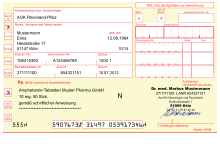Narcotic prescription
A narcotics prescription (BtM prescription ) is a special form for prescribing narcotics such as morphine , fentanyl or methylphenidate for delivery to patients, animals or for consultation hours. In contrast, narcotics request forms are used for ordering narcotics within hospitals and for all other types of narcotics trade.
Legal basis
The prescription of narcotics is regulated in the Narcotics Prescription Ordinance. Section 8 provides that narcotics may only be prescribed on a special, official three-part copy record (narcotics prescription). These forms are produced by the Bundesdruckerei and issued by the Federal Opium Office to the individual doctor, dentist or veterinarian on request. The forms are numbered; the whereabouts of each individual sheet is precisely documented. Foreign or outdated prescription forms are invalid.
These prescriptions must be kept in a safe place by the doctor to prevent them from being lost and thus misused. Every BtM prescription consists of three parts, two of which (Part I and III) are copies of the first (Part II). One of these parts (Part III) must be filled in and kept by the prescribing doctor for three years for documentation purposes, the second part (Part I) is kept for the same period in the dispensing pharmacy . The third part (Part II), like any normal prescription, is used for accounting with the insurance provider. The prescriptions must be completely filled out , that is to say with dosage instructions (note “according to written instructions” is sufficient) and dispensed amount ( packaging size labeling is not sufficient), and must be personally signed by the doctor; unlike on normal prescriptions, the unabridged signature is required. If the doctor's stamp of a group practice is used, the name of the prescribing doctor must also be noted or made particularly recognizable; the telephone number is also required.
No more than two narcotics may be prescribed at the same time; however, any number of different dosage forms for each narcotic drug (the simultaneous prescription of morphine ampoules, morphine drops, morphine tablets 10 mg and morphine prolonged-release tablets is permitted). In addition, only certain maximum amounts may be prescribed within 30 days (for example morphine: 24,000 mg). To facilitate pain therapy , doctors may deviate from these rules in justified cases; such ordinances are to be marked with an A.
Exceptions and special regulations
A doctor may prescribe more than two BtM and more than the maximum amount for a long-term patient in individual cases . The doctor must mark such exceptions with a capital "A" on the prescription.
BtM prescriptions that are used for substitution therapy for opioid addicts are to be marked with an “S” (e.g. buprenorphine ). As a rule, only specialists with the additional designation “basic addiction medical care” (ie no veterinarians or dentists) are entitled to substitution. Occasionally it can happen that in an emergency a BtM is prescribed on a "normal" prescription. The normal prescription then contains the note "Emergency prescription" and must not be older than one day. A BtM prescription which is marked with an "N" must be submitted immediately.
Narcotics may only be dispensed on BtM prescriptions that were issued no more than seven days in advance when presented to the pharmacy.
See also
Web links
Individual evidence
- ↑ Federal Law Gazette . In: www.bgbl.de. Retrieved May 20, 2016 .
- ↑ § 9 of the Narcotics Prescription Ordinance .
- ↑ § 12 of the Narcotics Prescription Ordinance.


